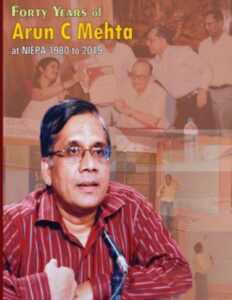EDUCATION FOR ALL IN INDIA: ENROLMENT PROJECTIONS
By Arun C. Mehta, Publishers: National Institute of Educational Planning and Administration (NIEPA), New Delhi and Vikash Publishing House Private Limited, 576 Masjid Road, Jangapura, New Delhi – 110016 (INDIA), 1998, Price Indian Rupee 335 Only (US $ 9)
INTRODUCTION
The book `Education for All in India: Enrolment Projections’ examines prospects of achieving goal of `Education For All’ in general and `Universalisation of Elementary Education’ in particular in India. For this, it critically analyses the educational development that has taken place in the country in the last fifty years. It provides the much needed projections of enrolment at the Primary and Upper primary levels of education for the country as a whole as well as for fourteen major states of India. For this, two well-known methods, one based on analysis of past trends, and the other on analyses of `Student Flow’ data have been used.
Based on different sets of assumptions about the flow parameters, namely, entry rate, promotion, repetition and dropout rates, several alternative projections have been made. By using the pattern of over-age and under-age children in different age-groups, it refines projected enrolment which is used to know the status of ‘universal enrolment’ as well as the likely year by which a particular state is likely to achieve the goal of universal enrolment. State-specific number of out-of-school children and children needed to be enrolled to achieve the goal of universal enrolment is also presented.
The book is divided into six chapters. The first chapter presents general information of the study with regard to period of projections, data used and sources, chapter scheme and softwares utilized in carrying out projections which is followed by a detailed analysis of educational development that has taken place in the country in Chapter two. A variety of indicators, such as, growth rates and index numbers over the last fifty years have been computed and extensively utilized. The methodology of the study undertaken is presented in Chapter three, which is followed by the results of the trend analysis. In Chapter five, results of the `student cohort’ model have been presented which a chapter follows on future prospects.References have been presented at the end.





